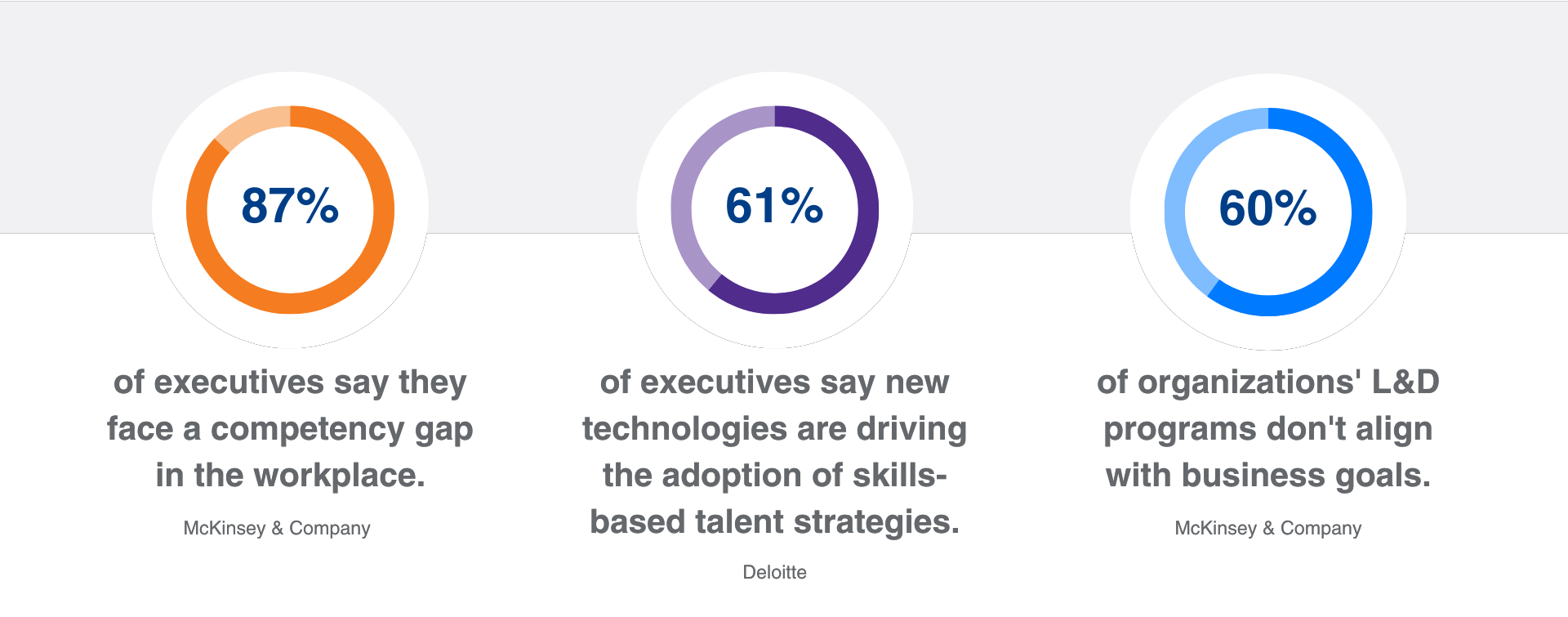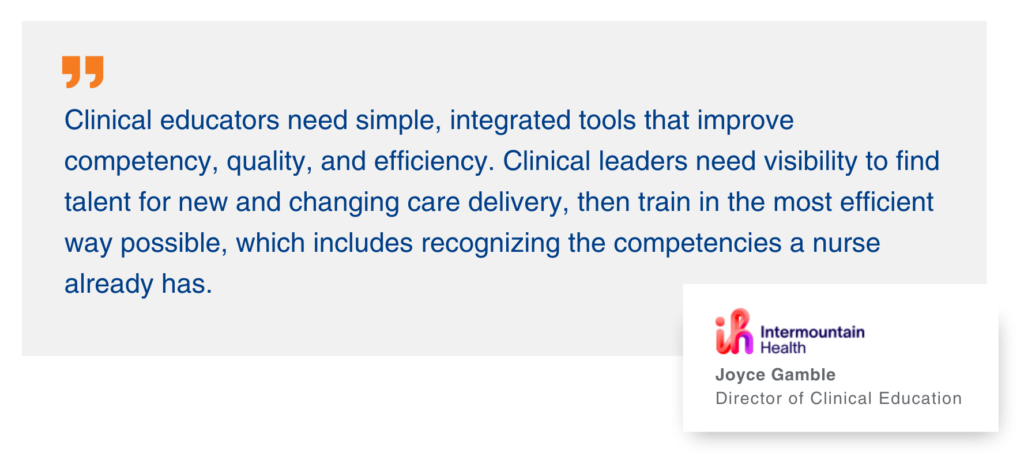Unlocking the full potential of your organization isn’t solely about deploying the latest and greatest technology, finding the perfect talent, or deploying new initiatives. It’s about implementing and sustaining an operational strategy that aligns all of this together — all business functions, people, processes, and technology — to guide the organization in planning, executing, and achieving business goals. This is where competency management comes into play — a critical strategy that aligns workforce and operational capability to accomplish business objectives.
Table of Contents
Frequently Asked Questions About Competency Management
Competency management is the strategic business process of identifying the necessary skills for employees to perform their job roles, assessing them based on specific criteria, and developing them to meet business needs and goals.
A competency is the required knowledge, skill, ability, experience, certification, or understanding for an employee to perform their job. Competencies are the building blocks of an employee’s job role and lay the foundation for what is expected of them, how tasks should be performed, and what development opportunities need to be addressed.
A competency gap is the difference between what an employee (or workforce) is capable of doing and what is required of them to achieve specific objectives. To close competency gaps, organizations need insight into validated data that shows what gaps exist paired with targeted training and development activities to guide employees.
Common features of a competency management system include:
- Competency Matrix to view competency assessments and gaps in one single view.
- Employee Dashboard to better understand strengths, weaknesses, and development opportunities for individuals in the workforce.
- Competency Assessments that work flexibly with your organization’s specific assessment structure.
- Assignment Workbench to assign, remove, and exempt competencies for individuals or across teams, job roles, locations, etc.
- Development Plans to provide specific training and development opportunities for employees to reach desired proficiency levels.
- Talent Finder to find the right person for the right job based on specific search criteria.
- Capability Building to understand how workforce capability compares to organizational needs or goals.
- Mobile Functionality to navigate through assessments on the plant floor, at the bedside, or in the field.
- Analytics to better understand and analyze workforce competencies, competency gaps, and alignment with regulatory requirements to staff projects and teams, or plan operational strategies.
A competency management system provides critical insights into employees’ skills, abilities, and knowledge across the organization. In a digital environment, competency data is more accessible and user-friendly and produces important insights that guide strategic talent and operating decisions better than Excel sheets, binders, or folders.
A competency-based or skills-based system enables an organization to staff projects, teams, and jobs based on an employee’s proficiency in requirements. Ultimately, a competency-based system increases employee engagement, reduces turnover, enhances customer satisfaction, improves efficiency, reduces training costs, and improves operational performance overall.
Understanding Competency Management

Competency management is the business process of identifying the skills needed for each employee to perform their job role, assessing proficiency levels against the required targets, strategically developing the workforce, and making informed operational decisions based on validated data.
Kahuna defines the competency management process in four phases: Curate, Assign, Assess, and Develop.
Curate: Curate organizational skills, competency frameworks, and content to reflect how roles within the organization are actually performed.
Assign: Assign content to employees based on their job roles, rather than fixed job codes.
Assess: Assess employee proficiency levels against required targets to create validated proficiency data.
Develop: Develop employees specifically with personalized development plans based on skills gaps, business needs, and professional development goals.
Components of Competency Management
Each component of the competency management software contributes to the development, assessment, and optimization of workforce skills and capabilities. There are many moving parts to competency management, but here are some key components to consider.
Competency Framework
A critical component is the competency framework, which is used to guide and outline specific skills, behaviors, and knowledge required for success. This framework serves as the foundation for the program, including the company’s talent strategy, assessment methodology, and the tools used to collect data. When creating the framework, it’s important to work cross-organizationally with HR, L&D, and Operations to establish robust content that will support the business holistically.
Robust Feedback Mechanism
A competency management program is not a one-and-done activity. It requires robust feedback and performance reviews to ensure the program is targeting the right knowledge, skills, and abilities, and fostering continuous growth in the organization.
Personalized Learning and Development Opportunities
Employee development is a key factor in any competency management program. As competency gaps are identified, employees should be connected with specific learning opportunities that meet their development needs. Ultimately, this can reduce time to productivity, decrease unnecessary training, and empower employees, among other benefits.
Continuous Monitoring and Analysis
With any competency management program, continuous monitoring will need to occur to analyze how the program is performing and impacting operations. Changes may need to be made to the competency framework itself, data collection or analysis methods, or even to how the program is presented or deployed to the workforce.
Overall, if the competency management program’s components are well-developed, it will enhance individual and organizational goals, workforce agility, and contribute to a sustained competitive advantage.
Benefits of Competency Management
Competency management offers a host of benefits for both the workforce and the business. Here are some key advantages:
- Understand competency gaps for individuals, teams, and the organization as a whole.
- Strategically plan training and development activities to target competency gaps, unmet regulatory requirements, industry demands, project-specific needs, etc.
- Deploy and staff resources more strategically based on how competency and capability align with job requirements.
- Empower employees to own their professional development with insights into career progression and training opportunities.
- Improve employee engagement, and retain talent and critical knowledge.
- Ensure safety, compliance, and quality are implemented as standard operating procedures.
- Make more informed talent decisions based on how workforce capability aligns with operational needs.
- Increase operational agility with more a flexible, cross-functional workforce.
Competency Management Tools and Technology
Rolling out a sustainable competency management program relies on how efficient and effective it is at capturing workforce data. There are a variety of methods in which organizations may choose to do so, with some competency management tools providing more value, insight, and flexibility than others.
Files, Folders, Excel Spreadsheets, or Homegrown Systems
Some organizations choose to construct their programs in files, folders, extensive Excel spreadsheets, or a homegrown application. However, paper-based options often prove to be burdensome and time-consuming and result in lost productivity and a lack of consumable data to inform business decisions. Homegrown applications are difficult to manage and often use resources and funding that can’t be supported over time.
Traditional HRIS
Often organizations try to construct competency management within an existing system in their organization — a traditional HRIS like Oracle, Workday, SAP Success Factors, or Cornerstone. However, these technologies weren’t built to ingest complex competency data or support the granularity of assessment and reporting techniques needed to inform operational decisions.
Competency Management Software
Digital competency management software is designed to organize, assess, and validate workforce competencies, and help the business use informed data to make strategic decisions. Some competency management software is plug-and-play, some are based on AI-inferred skills, and others, like Kahuna, are customizable to your organization’s specific competency framework data.
The Importance of Competency Management Software
Competency Management software helps to streamline the competency process, enabling data to be more accessible across the organization for front-line employees, managers, and executives. With the right solution, leaders are able to make more informed operational decisions and guide the workforce in performing their job roles more effectively and efficiently.
When searching for the top competency management platform, it’s important to think about what processes your organization’s competency program follows and then find a solution that meets those needs and requirements. Here are a couple of things to keep in mind.
- Does the platform ingest your competency framework data to reflect how your business operates?
- Can the platform account for granular variances in job roles, locations, units, etc. when assigning competencies across job roles?
- Will the platform support different proficiency scales across competencies?
- Can multiple assessment approaches be used?
- How does the system support employee development?
- What integration functionality does the competency management system have?
- What type of customer support does the competency software have?
DOWNLOAD OUR SAMPLE RFP
Searching for the right competency management software can be tricky
Our Competency Management Software Sample RFP provides a full list of questions and requirements you can ask vendors to ensure you find the right solution for your organization.
Competency Management Case Studies
Intermountain Healthcare Reduces Redundant Training and Decreases Time to Competence
Intermountain Health, the largest nonprofit system in the Intermountain West, began transforming its competency management program in 2010 with goals to ensure standards of care, support patient demand, deploy caregivers quickly, and eliminate redundant and inefficient training. Working alongside internal experts and external analysts, they created a library of 6,500 nursing skills describing the details of each skill required for each role.
Working with Kahuna to digitize healthcare competencies, Intermountain has validated more than 4.2 million competencies and saved an average of 18.2 hours per user in redundant training with a cost savings of $15 million across their health system.
How did they do it? Previously, each time a nurse transferred from one unit to another, their skills were retested and their training was repeated, even if they had decades of experience. Because testing methods varied by location, there was no way to validate and record what a nurse already knew. Digitized competency management enabled Intermountain to standardize assessments, validate proficiency levels, identify competency gaps, target training to specific gaps, reduce unnecessary training, and increase nurse mobility across their health system.

Streamline Manufacturing Training, Skills, and Operational Processes
As part of an overall smart manufacturing and digital transformation initiative, a leading Fortune 500 manufacturer began focusing on workforce readiness and development. They realized that to meet business objectives and operational requirements, they needed a better understanding of workforce capability to determine training and staffing needs for their global workforce of more than 50,000.
Digitized skills and competency management with Kahuna enabled the organization to face the manufacturing challenges within their organization, standardize manufacturing skills data, automate tracking of safety training and certifications, deploy a more robust on-the-job training program, backfill roles quickly, reduce operational expenditures, and retain critical employee knowledge. Since the initial deployment of Kahuna, the manufacturer has onboarded more than ⅓ of their planned sites and is on track to continue deploying the competency management program to more than 50 plants in total.
Learn more about how this Fortune 500 organization standardized its manufacturing skills, training, and operational processes with Kahuna.
Yinson Prioritizes Safety and Compliance of Fleet Workforce
Yinson, an energy infrastructure and technology organization, prioritizes operational health and safety, and training and development across their workforce. To ensure regulatory compliance was solidified into everyday operations, they realized the need for a system to track and validate workforce skills and training.
Implementing digitized competency management alleviated the manual tracking of employee skills, training, compliance, and certifications; improved the ability to close energy skills gaps; enabled accurate resource deployment based on required proficiency levels; and certified to customers that each member of the fleet workforce is licensed to operate safely and efficiently. Ultimately, Kahuna supports Yinson across their global operational environment and engrains offshore competency assurance practices into standard operating procedures.
Competency Management Enables Operational Agility
People are the most important asset to an organization and understanding their capability is essential to reaching target goals. With validated workforce competency data, leaders can plan more strategically to align capability to business and operational needs. Connect with a Kahuna skills advisor to learn more about how to deploy competency management across your business.







